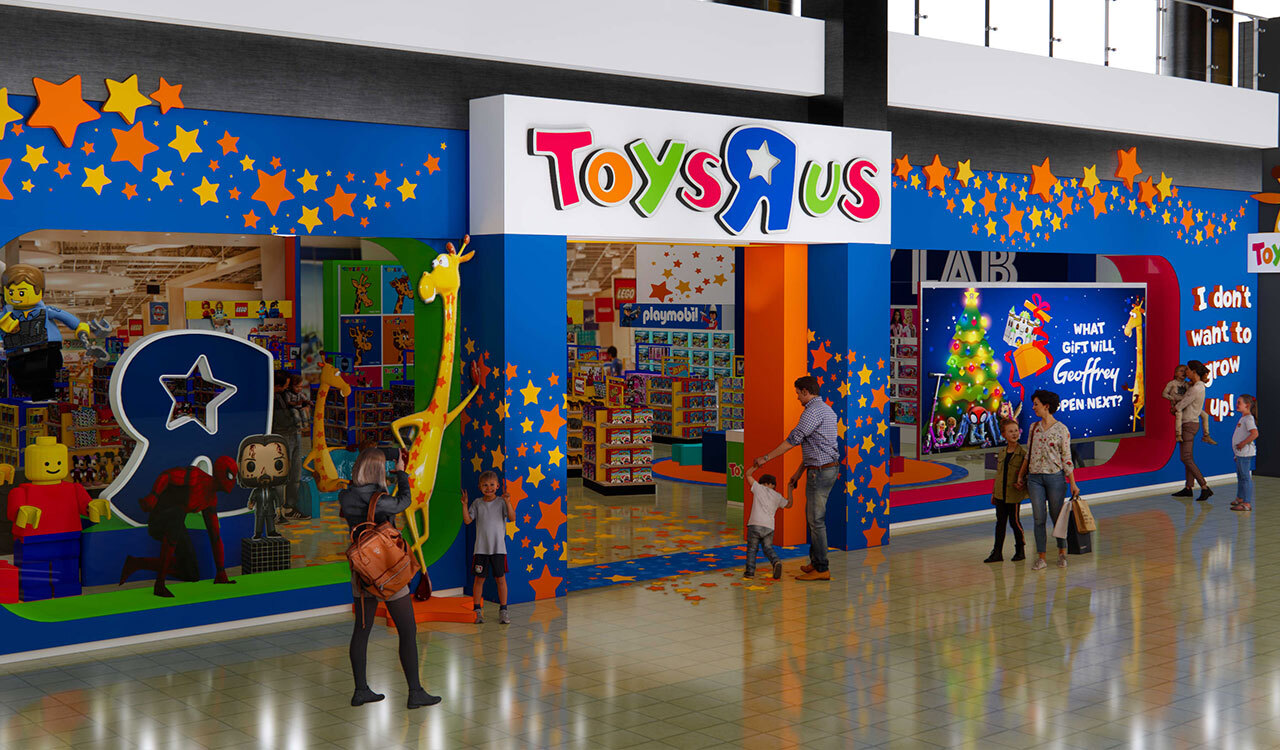Let’s speculate about Geoffrey, the lovable giraffe-like “mascot” of the once category-killer Toys”R”Us stores. To review, the brand went public in 1978, and during the peak of its power in the 1980s, had 1450 locations globally, selling 18,000 different toys, including all of the major toy brands. Indeed, they owned a 25 percent share of the overall toy industry.
Geoffrey also became somewhat of a TV star as TRU’s marketing strategy rolled him out across the country. The store’s TV spots also became even more iconic with a catchy jingle that featured a self-identified Peter Pan, “I’m a Toys‘R’Us kid,” who didn’t want to grow up.
My question about Geoffrey: Is it possible that the power of nostalgia is enough to spark a return of his lovable stardom image among a whole new generation of kids with a whole new set of values. Will we think of the Geoffrey renaissance as “Barbie redux?”
“WHP is betting on that nostalgic desire for the resurrection of the TRU brand and is simply pacing itself. In my opinion, if they execute the distribution moonshot, pushing to expand magical ubiquity, wherever and whenever a toy seeker may be, then I believe TRU will have a successful rise from the ashes.”
WHP Global’s Distribution Moonshot
While the Barbie analogy may be a bit of a longshot, TRU’s owner and strategic visionary, CEO Yehuda Shmidman, along with his staff at the WHP Global brand management firm, are making what I would call a distribution moonshot. This consists of a huge bet on the dormant strength of the TRU brand, and if Geoffrey can strike a nostalgic, Barbie-like demand surge, all the better.
So, betting on pent-up customer demand that has been lying in wait for TRU’s resurrection, WHP has planned for an overwhelming land, air, sea, and digital distribution assault to make its magical presence ubiquitous (a consistently superb customer experience), wherever, and whenever toy seekers may be. This does not imply a return to 60,000-square-foot warehouse-like stores selling 18,000 different toys. The plan will drive precision, localized assortments in more boutique-like shops and pop-ups. Not so incidentally, I would conjecture that Barbie will be sprinkled throughout the new TRU distribution fleet. And unlike the antiquated “stack ‘em high and let ‘em fly” retail models of the last century, interactive compelling experiences are being created to bring the toys to life.
Along with about 480 existing shops within Macy’s select locations and a store in New Jersey’s American Dream mall, WHP plans to launch 24 new “flagships,” not to cannibalize Macy’s locations, but to compliment them in nearby trading areas.
Sticking with the military analogy, the “air assault” includes shops in airports (the total number is unrevealed, but the first of these is slated to open in the Dallas/Fort Worth airport in a duty-free store). And from the sea, WHP is pursuing boutiques/pop-up concepts onboard cruise lines. TRU’s ecommerce and integrated omnichannel model have become table stakes for all of retail, So, WHP will focus on TRU’s optimization of seamless operations integration as well as up the interactive customer experience.
What Happened to TRU’s Original Dominance?
Not surprisingly, in 1978 original visionary and founder of TRU, Charles Lazarus, had an idea that was deceptively simple: Build a massive supermarket for toys. In post-WWII, he realized there would be a baby boom, and he was planning ahead.
Lazarus bought and sold so many toy brands that he was able to negotiate contracts to buy them far cheaper than his competitors. Because of the enormous selection, it broke the seasonal cycle of toy sales, inviting families to buy toys like they buy groceries. This made Toys ‘R’ Us into what retail historians recognize as the first “category killer”—a company that so completely dominates the retail category that it drives all its competition out of business.
So, as TRU marched forward toward its 25 percent share of market, it helped turn a $500 million toy industry in 1950 into one worth $12 billion in 1990.
Of course, this kind of incredible growth does not go unnoticed. Walmart, then Target and Amazon, all dove into the category. Also not surprisingly, TRU began to flex its pricing strategies even lower, as well as competitively editing its assortments, losing some of their innovative product-mix edge.
In 1994, Charles Lazarus stepped down as CEO after nearly a half-century of thrilling kids and their parents.
The Inevitable Squeeze
Erin Blakemore writes on her History website, “Toys ‘R’ Us faced other challenges over the years, like the rise of ecommerce, changing toy tastes, a transfer to private hands in 2005, and a leveraged buyout that failed spectacularly. The stores themselves became increasingly dated.
“But ultimately (and ironically), Toys ‘R’ Us became a casualty of the big-box model it helped create. The original category killer was killed by big-box stores that were even bigger and more powerful than Lazarus’ behemoth. Worried about competition from Walmart, Target and Amazon, executives began to winnow the number of toys the store carried and focus even more on slashing prices.
“But as Toys ‘R’ Us dialed back its offerings, it cut back on the magic, too. When Toys ‘R’ Us changed its focus from the toys themselves to undercutting the competition, you didn’t get the elation anymore. They failed because they ceased to love toys.”
So, What’s Next?
WHP is betting on that nostalgic desire for the resurrection of the TRU brand and is simply pacing itself. In my opinion, if they execute the distribution moonshot, pushing to expand magical ubiquity, wherever and whenever a toy seeker may be, then I believe TRU will have a successful rise from the ashes.
And Geoffrey will have a second and wonderful new life.




